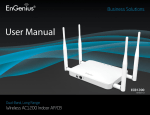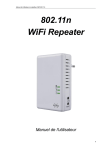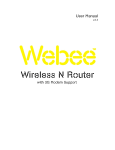Download RayTalk RA-635S User`s manual
Transcript
RayTalk RA-635S High Sensitivity 11b/g Wireless Access Point Smoke Detector User’s Manual Version: 1.2 Copyright © RayTalk Industries. Tutti i diritti riservati. Declaration of Conformity We, the under signed RayTalk Industries Srl Via Nicolino di Galasso 19 47899 Serravalle Republic of SAN MARINO Tel: +378 0549 901170 Fax: +378 0549 900890 Contact: Mr. Gianluigi Savioli E-Mail: [email protected] declare under our own responsibility that the product : Brand Name Model Descriptions Applicant RayTalk RA-635S R- LAN (IEEE 802.11 b/g) WIRELESS ACCESS POINT RayTalk Industries Srl to which this declaration refers conforms with the relevant standards: Standard EN 50385 EN 60950-1 EN 301 489-1 EN 301 489-17 EN 55022 EN 300 328 Issue date 2002 2006 V1.6.1 (2005-09) V1.2.1 (2002-08) 2006+A1:2007, CLASS B V1.7.1 (2006-10) We hereby declare that the essential radio tests suites have been carried out and that the above named product is in conformity with all the essential requirements of R&TTE Directive 1999/5/EC. The technical construction file as required by the Conformity Assessment procedure is kept at the address of applicant. The product RayTalk RA-635S has been tested and found to comply with the stated standards which are required by the article 6.4 of the R&TTE Directive of 99/5/EEC. This equipment may be operated in: IT Note: the use of the present equipment in the Italian regulation is ruled by the following directives: • D.Lgs 1.8.2003, n.259 articles 104 and 105 for private use • D.M. 28.5.2003 and further modifications for R-LAN and telecommunication services with public access Gianluigi Savioli / Amministratore Unico RayTalk Industries Srl Date: June 24th, 2010 Copyright © RayTalk Industries. Tutti i diritti riservati. Table of Contents 1. INTRODUCTION ............................................................................................................................... 3 1.1. 1.2. 1.3. 1.4. 1.5. 1.6. 2. a) b) HARDWARE INSTALLATION ........................................................................................................... 8 IP ADDRESS CONFIGURATION ....................................................................................................... 9 ACCESS POINT / WDS OPERATING MODE ..............................................................................11 3.1. 3.2. 3.2.1. 3.2.2. 3.2.3. 3.3. 3.3.1. 3.3.2. 3.4. 3.4.1. 3.4.2. 3.4.3. 3.4.4. 3.4.5. 3.4.6. 3.4.7. 3.5. 3.5.1. 3.5.2. 3.5.3. 3.5.4. 3.5.5. 3.5.6. 3.5.7. 4. Ad-hoc (peer-to-peer) Mode.................................................................................................................... 6 Infrastructure Mode ................................................................................................................................. 7 UNDERSTANDING THE HARDWARE .......................................................................................... 8 2.1. 2.2. 3. FEATURES & BENEFITS ................................................................................................................. 4 PACKAGE CONTENTS .................................................................................................................... 5 ACCESS POINT DESCRIPTION ........................................................................................................ 5 SYSTEM REQUIREMENTS .............................................................................................................. 5 APPLICATIONS .............................................................................................................................. 6 NETWORK CONFIGURATION ......................................................................................................... 6 LOGGING IN................................................................................................................................ 12 STATUS ....................................................................................................................................... 14 MAIN – SYSTEM STATUS ............................................................................................................. 14 CLIENT LIST ............................................................................................................................... 15 SYSTEM LOG .............................................................................................................................. 15 SYSTEM ...................................................................................................................................... 16 SYSTEM PROPERTIES .................................................................................................................. 16 IP SETTINGS ............................................................................................................................... 16 WIRELESS ................................................................................................................................... 18 WIRELESS NETWORK ................................................................................................................. 18 WIRELESS SECURITY - WEP ....................................................................................................... 20 WIRELESS SECURITY – WPA-PSK, WPA2-PSK, WPA-MIXED .................................................. 21 WIRELESS SECURITY – WPA, WPA2 .......................................................................................... 22 WIRELESS MAC FILTER ............................................................................................................. 23 WDS LINK SETTINGS ................................................................................................................. 23 WIRELESS ADVANCED SETTINGS ................................................................................................ 24 MANAGEMENT ........................................................................................................................... 25 ADMINISTRATION ....................................................................................................................... 25 MANAGEMENT VLAN ................................................................................................................ 26 SNMP SETTINGS ........................................................................................................................ 26 BACKUP/RESTORE SETTINGS, RESET TO FACTORY DEFAULT SETTINGS ........................................ 27 FIRMWARE UPGRADE ................................................................................................................. 28 TIME SETTINGS .......................................................................................................................... 28 LOG ............................................................................................................................................ 29 REPEATER OPERATING MODE ................................................................................................. 30 4.1. 4.2. 4.2.1. 4.2.2. 4.2.3. 4.2.4. 4.3. 4.3.1. 4.3.2. 4.3.3. 4.4. LOGGING IN................................................................................................................................ 30 STATUS ....................................................................................................................................... 32 MAIN .......................................................................................................................................... 32 WIRELESS CLIENT LIST .............................................................................................................. 33 CONNECTION STATUS ................................................................................................................. 33 SYSTEM LOG .............................................................................................................................. 33 SYSTEM ...................................................................................................................................... 35 SYSTEM PROPERTIES .................................................................................................................. 35 IP SETTINGS ............................................................................................................................... 35 SPANNING TREE SETTINGS ......................................................................................................... 36 WIRELESS ................................................................................................................................... 37 Copyright © RayTalk Industries. Tutti i diritti riservati. 4.4.1. 4.4.2. 4.4.3. 4.4.4. 4.4.5. 4.5. 4.5.1. 4.5.2. 4.5.3. 4.5.4. 4.5.5. 4.5.6. WIRELESS NETWORK ................................................................................................................. 37 WIRELESS SECURITY - WEP ....................................................................................................... 38 WIRELESS SECURITY - WPA-PSK, WPA2-PSK ......................................................................... 39 WIRELESS MAC FILTER ............................................................................................................. 39 WIRELESS ADVANCED SETTINGS ................................................................................................ 40 MANAGEMENT ........................................................................................................................... 42 ADMINISTRATION ....................................................................................................................... 42 SNMP SETTINGS ........................................................................................................................ 42 BACKUP/RESTORE SETTINGS, RESET TO FACTORY DEFAULT SETTINGS ........................................ 43 FIRMWARE UPGRADE ................................................................................................................. 44 TIME SETTINGS .......................................................................................................................... 44 LOG ............................................................................................................................................ 45 APPENDIX A – SPECIFICATIONS ......................................................................................................... 46 2 Copyright © RayTalk Industries. Tutti i diritti riservati. 1. Introduction RA-635S is a smoke detector looking Wireless Access Point / Repeater / WDS that operates seamlessly in the 2.4 GHz frequency spectrum supporting the 802.11b (2.4GHz, 11Mbps) and faster 802.11g (2.4GHz, 54Mbps) wireless standards. It's the best way to add wireless capability to your existing wired network, or to add bandwidth to your wireless installation. This device features high transmitted output power and high receivable sensitivity along with antenna diversity. High output power and high sensitivity can extend range and coverage to reduce the roaming between Access Points to get more stable wireless connection. It also reduces the expense of equipment in the same environment. To protect your wireless connectivity, it can encrypt all wireless transmissions through 64/128-bit WEP data encryption and also supports WPA/WPA2. The MAC address filter lets you select exactly which stations should have access to your network. In addition, the User Isolation function can protect the private network between client users. The attractive design, high performance, and array of features makes this a suitable wireless solution for your residence or office. This chapter describes the features & benefits, package contents, applications, and network configuration. 3 Copyright © RayTalk Industries. Tutti i diritti riservati. 1.1. Features & Benefits Features Benefits High Speed Data Rate Up to 54Mbps Capable of handling heavy data payloads such as MPEG video streaming High Output Power up to 26 dBm Extended excellent Range and Coverage (fewer APs) IEEE 802.11b/g Compliant Fully Interoperable with IEEE 802.11b/IEEE802.11g compliant devices Embedded Antenna Users won’t see antenna in your building environment Point-to-point, Point-to-multipoint Wireless Connectivity Let users transfer data between two buildings or multiple buildings WDS (Wireless Distributed System) Make wireless AP and Bridge mode simultaneously as a wireless repeater Universal Repeater The easiest way to expand your wireless network's coverage Support Multi-SSID function (4 SSID) in AP mode Allow clients to access different networks through a single access point and assign different policies and functions for each SSID by manager Diversity support Enhance the traffic signal WPA2/WPA/ IEEE 802.1x support Powerful data security MAC address filtering in AP mode(up to 50) Ensures secure network connection User isolation support (AP mode) Protect the private network between client users. Power-over-Ethernet (IEEE802.3af) Flexible Access Point locations and cost savings Keep personal setting Keep the latest setting when firmware upgrade SNMP Remote Configuration Management Help administrators to remotely configure or manage the Access Point easily. QoS (WMM) support Enhance user performance and density 4 Copyright © RayTalk Industries. Tutti i diritti riservati. 1.2. Package Contents Open the package carefully, and make sure that none of the items listed below are missing. Do not discard the packing materials, in case of return; the unit must be shipped in its original package. h h h h h h 1.3. One Wireless Access Point Smock Detector (RA-635S) One Power Adapter (12V/1A) One CAT5 UTP Cable One Quick Installation Guide One Declaration of Conformity One CD-ROM with User’s Manual Access Point Description Front Panel 1.4. Rear Panel System Requirements The following are the minimum system requirements in order configure the device. h PC/AT compatible computer with a Ethernet interface. h Operating system that supports HTTP web-browser 5 Copyright © RayTalk Industries. Tutti i diritti riservati. 1.5. Applications The wireless LAN products are easy to install and highly efficient. The following list describes some of the many applications made possible through the power and flexibility of wireless LANs: a) Difficult-to-wire environments There are many situations where wires cannot be laid easily. Historic buildings, older buildings, open areas and across busy streets make the installation of LANs either impossible or very expensive. b) Temporary workgroups Consider situations in parks, athletic arenas, exhibition centers, disasterrecovery, temporary offices and construction sites where one wants a temporary WLAN established and removed. c) The ability to access real-time information Doctors/nurses, point-of-sale employees, and warehouse workers can access real-time information while dealing with patients, serving customers and processing information. d) Frequently changed environments Show rooms, meeting rooms, retail stores, and manufacturing sites where frequently rearrange the workplace. e) Small Office and Home Office (SOHO) networks SOHO users need a cost-effective, easy and quick installation of a small network. f) Wireless extensions to Ethernet networks Network managers in dynamic environments can minimize the overhead caused by moves, extensions to networks, and other changes with wireless LANs. g) Wired LAN backup Network managers implement wireless LANs to provide backup for mission-critical applications running on wired networks. h) Training/Educational facilities Training sites at corporations and students at universities use wireless connectivity to ease access to information, information exchanges, and learning. 1.6. Network Configuration To better understand how the wireless LAN products work together to create a wireless network, it might be helpful to depict a few of the possible wireless LAN PC card network configurations. The wireless LAN products can be configured as: a) Ad-hoc (or peer-to-peer) for departmental or SOHO LANs. b) Infrastructure for enterprise LANs. a) Ad-hoc (peer-to-peer) Mode This is the simplest network configuration with several computers equipped with the PC Cards that form a wireless network whenever they 6 Copyright © RayTalk Industries. Tutti i diritti riservati. are within range of one another. In ad-hoc mode, each client is peer-topeer, would only have access to the resources of the other client and does not require an access point. This is the easiest and least expensive way for the SOHO to set up a wireless network. The image below depicts a network in ad-hoc mode. b) Infrastructure Mode The infrastructure mode requires the use of an access point (AP). In this mode, all wireless communication between two computers has to be via the AP. It doesn’t matter if the AP is stand-alone or wired to an Ethernet network. If used in stand-alone, the AP can extend the range of independent wireless LANs by acting as a repeater, which effectively doubles the distance between wireless stations. The image below depicts a network in infrastructure mode. 7 Copyright © RayTalk Industries. Tutti i diritti riservati. 2. Understanding the Hardware 2.1. 1 2 3 Hardware Installation Place the unit in an appropriate place after conducting a site survey. Plug one end of the Ethernet cable into the RJ-45 port on the rear panel of the device and another end into your PC/Notebook. Insert the DC-inlet of the power adapter into the port labeled “DC-IN” and the other end into the power socket on the wall. This diagram depicts the hardware configuration PC Ethernet Access Point AC/DC cable Power Outlet 8 Copyright © RayTalk Industries. Tutti i diritti riservati. 2.2. IP Address Configuration The default IP address of the device is 192.168.1.1. In order to log into this device, you must first configure the TCP/IP settings of your PC/Notebook. 1. In the control panel, double click Network Connections and then double click on the connection of your Network Interface Card (NIC). You will then see the following screen. 2. Select Internet Protocol (TCP/IP) and then click on the Properties button. This will allow you to configure the TCP/IP settings of your PC/Notebook. 9 Copyright © RayTalk Industries. Tutti i diritti riservati. 3. Select Use the following IP Address radio button and then enter the IP address and subnet mask. Ensure that the IP address and subnet mask are on the same subnet as the device. For Example: Device IP address: 192.168.1.1 PC IP address: 192.168.1.10 PC subnet mask: 255.255.255.0 4. Click on the OK button to close this window, and once again to close LAN properties window. 10 Copyright © RayTalk Industries. Tutti i diritti riservati. 3. Access Point / WDS Operating Mode Access Point Access Point + WDS (Wireless Distribution System) 11 Copyright © RayTalk Industries. Tutti i diritti riservati. 3.1. Logging In To configure the device through the web-browser, enter the IP address of the Bridge (default: 192.168.1.1) into the address bar of the web-browser and press Enter. Make sure that the Bridge and your computers are on the same subnet. Refer to Chapter 2 in order to configure the IP address of your computer. Username:admin; Password:admin 1. 2. 3. 4. After logging in you will see the graphical user interface (GUI) of the device. The navigation dropdown menu on left is divided into four main sections: Status: This includes the main status page, DHCP client list, and system log. System: This includes the system properties and IP settings. Wireless: This includes the basic, advanced, security, WDS, and MAC filter for the wireless interface. Management: This includes the administrator password settings, VLAN and SNMP settings, backup/restore configuration, firmware upgrade, time settings, and the system log. The status page is also displayed once you have logged in. This includes details about the system, wireless, and TCP/IP configuration. 12 Copyright © RayTalk Industries. Tutti i diritti riservati. 13 Copyright © RayTalk Industries. Tutti i diritti riservati. 3.2. Status Click on the Status link on the navigation drop-down menu. You will then see three options: main, client list, and system log. Each option is described below. 3.2.1. Main – System Status The Main page is the first page that is displayed once you have logged in. The following information is included on this page: o System Information – device name, Ethernet MAC address, Wireless MAC address, country, current time, firmware version, and VLAN management tag. o Current IP Settings: IP address, subnet mask, default gateway, and DHCP client status. o Current Wireless Settings: Operation mode, wireless mode, channel frequency, profile isolation, profile settings such as SSID, and security settings. 14 Copyright © RayTalk Industries. Tutti i diritti riservati. 3.2.2. Client List Click on the Client List link to view a list of devices that are associated with the Access Point. Click on the Refresh button to view an updated list of devices that are associated with the Access Point. 3.2.3. System Log The System Log page displays a list of events that are triggered on the Ethernet and Wireless interface. This log can be referred to when an unknown error occurs on the system or when a report needs to be sent to the technical support department for debugging purposes. 15 Copyright © RayTalk Industries. Tutti i diritti riservati. 3.3. System Click on the System link on the navigation drop-down menu. You will then see two options: system properties and IP settings. Each option is described below. 3.3.1. System Properties The System Properties allows you to configure a name for the device (this is not the SSID), select and country and the operational mode. Device Name: Specify a name for the device – this is not the SSID. Country/Region: Select the region from the drop-down list. Operation Mode: Select Access Point or Repeater radio button. In order to configure the Repeater, click on the WDS Link Settings under the Wireless dropdown menu. Click on the Apply button to save the changes. 3.3.2. IP Settings The IP Settings page allows you to configure the device with a static IP address or a DHCP client. 16 Copyright © RayTalk Industries. Tutti i diritti riservati. IP Network Setting: Select Obtain an IP address automatically (DHCP) radio button if the Access Point is connected to a DHCP server. This will allow the Access Point to pass IP addresses to the clients associated with it. You may select Specify an IP Address radio button if you would like the device to use a static IP address. In this case, you would be required to specify an IP address, subnet mask, and default gateway IP address. IP Address: Specify an IP address IP Subnet Mask: Specify the subnet mask for the IP address Default Gateway: Specify the IP address of the default gateway. Click on the Apply button to save the changes. 17 Copyright © RayTalk Industries. Tutti i diritti riservati. 3.4. Wireless Click on the Wireless link on the navigation drop-down menu. You will then see four options: wireless network, wireless MAC filter, WDS link settings, and wireless advanced settings. Each option is described below. 3.4.1. Wireless Network The Wireless Network page allows you to configure the wireless mode, channel, SSID, and security settings. Wireless Mode: Depending on the type of wireless clients that are connected to the network, you may select B, G, or B/G-mixed. If you are not sure about which clients will be accessing the wireless networks, it is recommended that you select B/Gmixed for the best performance. Channel: Select a channel from the drop-down list. The channels available are based on the country’s regulation. When selecting Infrastructure mode, a channel is not required, however, when selecting Adhoc mode, you must select the same channel on all points. Channel: You may configure up to four different wireless profiles. Click on the Edit button to modify the profile and place a check in the Enable box to activate the profile. 18 Copyright © RayTalk Industries. Tutti i diritti riservati. SSID: The SSID is a unique named shared amongst all the points of the wireless network. The SSID must be identical on all points of the wireless network and cannot exceed 32 characters. VLAN ID: If you have enabled VLAN tagging on your network, specify the VLAN tag ID. Suppressed SSID: Place a check in this box if you would like to hide the SSID. By enabling this feature, wireless clients will not be able to scan this access point in a site survey. Station Separator: This is also known as layer 2 isolation. Clients connected to this Access Point will not be able to directly communicate with each other. Security Mode: By default, the security is disabled. Refer to the next section to configure the security features such as WEP, WPA, WPA-PSK, WPA2, WPA2-PSK and WPA-Mixed Click on the Apply button to save the changes. 19 Copyright © RayTalk Industries. Tutti i diritti riservati. 3.4.2. Wireless Security - WEP Security Mode: Select WEP from the drop-down list if your wireless network uses WEP encryption. WEP is an acronym for Wired Equivalent Privacy, and is a security protocol that provides the same level of security for wireless networks as for a wired network. Authentication Type: Select an authentication method. Options available are Open Key, Shared Key or Auto. An open system allows any client to authenticate as long as it conforms to any MAC address filter policies that may have been set. All authentication packets are transmitted without encryption. Shared Key sends an unencrypted challenge text string to any device attempting to communicate with the Access PointP. The device requesting authentication encrypts the challenge text and sends it back to the Access Point. If the challenge text is encrypted correctly, the Access Point allows the requesting device to authenticate. It is recommended to select Auto if you are not sure which authentication type is used. Input Type: Select He or ASCII from the drop-down list Key Length: Select a key format from the drop-down list. 64bit-hex keys require 10 characters, where as 128-bit keys require 26 characters. A hex key is defined as a number between 0 through 9 and letter between A through F. Default Key: You may use up to four different keys for four different networks. Select the current key that will be used. Key 1-4: You may enter four different WEP keys. Click on the Apply button to save the changes. 20 Copyright © RayTalk Industries. Tutti i diritti riservati. 3.4.3. Wireless Security – WPA-PSK, WPA2-PSK, WPAMixed Security Mode: Select WPA-PSK, WPA2-PSK, or WPA-Mixed from the drop-down list if your wireless network uses WPA pre-shared key. Encryption: Select TKIP or AES from the drop-down list if your wireless network uses this encryption. WPA (Wi-Fi Protected Access) was designed to improve upon the security features of WEP (Wired Equivalent Privacy). The technology is designed to work with existing Wi-Fi products that have been enabled with WEP. WPA provides improved data encryption through the Temporal Integrity Protocol (TKIP), which scrambles the keys using a hashing algorithm and by adding an integrity checking feature which makes sure that keys haven’t been tampered with. Passphrase: Specify a passphrase that is shared amongst the Access Points and clients. Group Key Update Interval: Specify the number of seconds after which the Access Point will probe the client for the passphrase. Click on the Apply button to save the changes. 21 Copyright © RayTalk Industries. Tutti i diritti riservati. 3.4.4. Wireless Security – WPA, WPA2 Security Mode: Select WPA or WPA2 from the drop-down list if your wireless network uses WPA. WPA (Wi-Fi Protected Access) was designed to improve upon the security features of WEP (Wired Equivalent Privacy). The technology is designed to work with existing Wi-Fi products that have been enabled with WEP. WPA provides improved data encryption through the Temporal Integrity Protocol (TKIP), which scrambles the keys using a hashing algorithm and by adding an integrity checking feature which makes sure that keys haven’t been tampered with. Encryption: Select TKIP or AES from the drop-down list if your wireless network uses this encryption. RADIUS IP Address: Enter the IP address of the RADIUS server. RADIUS Port: Enter the port number of the RADIUS server. The default is usually 1812. RADIUS Secret: Enter the shared password of the RADIUS server. Group Key Update Interval: Specify the number of seconds after which the Access Point will probe the client for the secret. Click on the Apply button to save the change. 22 Copyright © RayTalk Industries. Tutti i diritti riservati. 3.4.5. Wireless MAC Filter Click on the Wireless MAC Filter link under the Wireless menu. On this page you can filter the MAC address by allowing or blocking access the network. ACL (Access Control) Mode: You may choose to Disable, Allow Listed, or Deny Listed MAC addresses from associating with the network. By selecting Allow MAC in the List, only the address listed in the table will have access to the network; all other clients will be blocked. On the other hand, selected Deny MAC in the List, only the listed MAC addresses will be blocked from accessing the network; all other clients will have access to the network. MAC Address: Enter the MAC address. This table lists the blocked or allowed MAC addresses; you may delete selected MAC address or delete all the addresses from the table by clicking on the Delete button. Click on the Apply button to save the changes. 3.4.6. WDS Link Settings Click on the WDS Link Settings On this page you can configure the WDS (Wireless Distribution System) which allows the Access Point to function as a repeater. 23 Copyright © RayTalk Industries. Tutti i diritti riservati. WDS MAC Address: Specify the MAC address of the Access Points that will join the WDS network and then select Enable or Disable from the drop-down list. Click on the Apply button to save the changes. 3.4.7. Wireless Advanced Settings Click on the Wireless Advanced Settings link. On this page you can configure the advanced settings to tweak the performance of your wireless network. Options available are: data rate, transmit power, antenna diversity, fragmentation threshold, RTS threshold, and 802.11g protection. Data Rate: If you would like to force a data rate, you may select one from the dropdown list. However, for best performance it is recommended to use the Auto setting. Transmit Power: You may have the different application distance of the device by selecting a value from the drop-down list. This feature can be helpful in restricting the coverage area of the wireless network. Fragment: Packets over the specified size will be fragmented in order to improve performance on noisy networks. RTS Threshold: Packets over the specified size will use the RTS/CTS mechanism to maintain performance in noisy networks and preventing hidden nodes from degrading the performance. Protection Mode: If your wireless network is using both 802.11b and 802.g devices then it is recommended to enable this feature so that the 802.11b devices will not degrade the performance of 802.11g devices. WMM: Choose to enable or disable wireless multimedia mode. Click on the Apply button to save the changes. 24 Copyright © RayTalk Industries. Tutti i diritti riservati. 3.5. Management Click on the Management link on the navigation drop-down menu. You will then see seven options: administration, management VLAN, SNMP settings, backup/restore settings, firmware upgrade, time settings, and log. Each option is described below. 3.5.1. Administration Click on the Administration link under the Management menu. This option allows you to create a user name and password for the device. By default, this device is configured without a user name and password Admin. For security reasons it is highly recommended that you create a new user name and password. Name: Specify a user name into the first field. Password: Specify a password into this field and then re-type the password into the Confirm Password field. Then click on the Apply button. Click on the Apply button to save the changes. 25 Copyright © RayTalk Industries. Tutti i diritti riservati. 3.5.2. Management VLAN Click on the SNMP link under the Management menu. This option allows you to assign a VLAN tag to the packets. A VLAN is a group of computers on a network whose software has been configured so that they behave as if they were on a separate Local Area Network (LAN). Computers on VLAN do not have to be physically located next to one another on the LAN Management VLAN ID: If your network includes VLANs and if tagged packets need to pass through the Access Point, specify the VLAN ID into this field. If not, select the No VLAN tag radio button. Note: If your reconfigure the Management VLAN ID, you may lose connectivity to the Access Point. Verify that the switch and DHCP server can support the reconfigured VLAN ID, and then re-connect to the new IP address. Click on the Apply button to save the changes. 3.5.3. SNMP Settings Click on the SNMP Settings link under the Management menu. This option allows you to assign the contact details, location, community name and trap settings for SNMP This is a networking management protocol used to monitor network-attached devices. SNMP allows messages (called protocol data units) to be sent to various parts of a network. Upon receiving these messages, SNMP-compatible devices (called agents) return data stored in their Management Information Bases. . 26 Copyright © RayTalk Industries. Tutti i diritti riservati. SNMP Enable/Disable: Choose to enable or disable the SNMP feature. Contact: Specify the contact details of the device. Location: Specify the location of the device. Read-Only Community Name: Specify the password for access the SNMP community for read only access. Read-Write Community Name: Specify the password for access to the SNMP community with read/write access. Send SNMP Trap: Specify the IP address of the computer that will receive the SNMP traps. Trap Community Name: Specify the password for the SNMP trap community. Click on the Apply button to save the changes. 3.5.4. Backup/Restore settings, Reset to factory default settings Click on the Backup/Restore Setting link under the Management menu. This option is used to save the current settings of the device in a file on your local disk or load settings on to the device from a local disk. This feature is very handy for administrators who have several devices that need to be configured with the same settings. Save a copy of the current settings: Click on the Backup button to save the current configuration. Restore saved settings from a file: Once a file has been backed up, you may restore it by clicking on the Browse button to select the file, and then the Restore button. Revert to factory default settings: Click on the Factory Default Settings button to reset the device to the default settings. Please wait while the device restart and then access the device using the default IP address: 192.168.1.1 27 Copyright © RayTalk Industries. Tutti i diritti riservati. 3.5.5. Firmware Upgrade Click on the Upgrade Firmware link under the Management menu. This page is used to upgrade the firmware on the device. Make sure that downloaded the appropriate firmware from your vendor. Click on the Browse button and then select the appropriate firmware and then click on the Upgrade button. Note: The upgrade process may take about 1 minute to complete. Do not power off the device during this process as it may crash the device and make it unusable. The device will restart automatically once the upgrade is complete. 3.5.6. Time Settings Click on the Time Settings link under the Management menu. This page allows you to configure the time on the device. You may do this manually or by connecting to a NTP server. Manually Set Date and Time: Specify the date and time Automatically Get Date and Time: Select the time zone from the drop down list and then specify the IP address of the NTP server. Click on the Apply button to save the changes. 28 Copyright © RayTalk Industries. Tutti i diritti riservati. 3.5.7. Log Click on the Log link under the Management menu. The Log page displays a list of events that are triggered on the Ethernet and Wireless interface. This log can be referred when an unknown error occurs on the system or when a report needs to be sent to the technical support department for debugging purposes. Syslog: Choose to enable or disable the system log. Log Server IP Address: Specify the IP address of the server that will receive the system log. Local Log: Choose to enable or disable the local log. Click on the Apply button to save the changes. 29 Copyright © RayTalk Industries. Tutti i diritti riservati. 4. Repeater Operating Mode 4.1. Logging In To configure the device through the web-browser, enter the IP address of the device (default: 192.168.1.1) into the address bar of the web-browser and press Enter. Make sure that the device and your computers are configured on the same subnet. Refer to Chapter 2 in order to configure the IP address of your computer. After connecting to the IP address, the web-browser will display the login page. Specify admin for both the user name and password. After logging in you will graphical user interface (GUI) of the device. The navigation drop-down menu on left is divided into four sections: 30 Copyright © RayTalk Industries. Tutti i diritti riservati. 1. 2. 3. 4. Status: Displays the overall status, wireless client list, connection status, and sytem log. System: This menu includes the system properties, IP and Spanning Tree settings. Wireless: This menu includes status, basic, advanced, and security. Management: This menu includes the admin setup, SNMP, firmware upgrade, time settings, log, and save/restore backup. 31 Copyright © RayTalk Industries. Tutti i diritti riservati. 4.2. Status Click on the Status link on the navigation dropdown menu. You will then see four optfions: Main, Wireless Client List, Connection Status, and System Log. Each option is described in detail below. 4.2.1. Main Click on the Main link under the Status drop-down menu. The status that is displayed corresponds with the operating mode that is selected. Information such as operating mode, system up time, firmware version, serial number, kernel version and application version are displayed in the ‘System’ section. LAN IP address, subnet mask, and MAC address are displayed in the ‘LAN’ section. In the ‘Wireless section, the frequency, channel is displayed. Since this device supports multiple-SSIDs, the details of each SSID, such as ESSID and its security settings are displayed. 32 Copyright © RayTalk Industries. Tutti i diritti riservati. 4.2.2. Wireless Client List Click on the Wireless Client List link under the Status drop-down menu. This page displays the list of Clients that are associated to the Access Point. The MAC addresses and signal strength for each client is displayed. Click on the Refresh button to refresh the client list 4.2.3. Connection Status Click on the Connection Status link under the Status drop-down menu. This page displays the current status of the network, including network type, SSID, BSSID, connection status, wireless mode, current channel, security, data rate, noise level and signal strength. 4.2.4. System Log Click on the System Log link under the Status drop-down menu. The device automatically logs (records) events of possible interest in its internal memory. If there is not enough internal memory for all events, logs of older events are deleted, but logs of the latest events are retained. 33 Copyright © RayTalk Industries. Tutti i diritti riservati. 34 Copyright © RayTalk Industries. Tutti i diritti riservati. 4.3. System Click on the System link on the navigation drop-down menu. You will then see three options: System Properties, IP Settings, and Spanning Tree Settings. Each option is described in detail below. 4.3.1. System Properties Click on the System Properties link under the System drop-down menu. This page allows you to switch the operating mode of the device, as well as specify a name and select the operating region. Device Name: Specify a name for the device (this is not the SSID), Country/Region: Select a country from the drop-down list. Operating Mode: Select and operating mode. Configuration for each operating mode is described in their respective chapters. Click on the Apply button to save the changes. 4.3.2. IP Settings Click on the IP Settings link under the System drop-down menu This page allows you to configure the device with a static IP address or a DHCP client. 35 Copyright © RayTalk Industries. Tutti i diritti riservati. IP Network Setting: Select Obtain an IP address automatically (DHCP) radio button if the Access Point is connected to a DHCP server. This will allow the Access Point to pass IP addresses to the clients associated with it. You may select Specify an IP Address radio button if you would like the device to use a static IP address. In this case, you would be required to specify an IP address, subnet mask, and default gateway IP address. IP Address: Specify an IP address IP Subnet Mask: Specify the subnet mask for the IP address Default Gateway: Specify the IP address of the default gateway. Click on the Apply button to save the changes. 4.3.3. Spanning Tree Settings Click on the Spanning Tree link under the System drop-down menu Spanning-Tree Protocol is a link management protocol that provides path redundancy while preventing undesirable loops in the network. Spanning Tree Status: Choose to enable or disable the spanning tree feature. Bridge Hello Time: Specify the number of seconds for the hello time. Bridge Max Age: Specify the number of seconds for the max age. Bridge Forward Delay: Specify the number of seconds for the bridge forward delay. Priority: Specify the number of seconds for the priority. Click on the Apply button to save the changes. 36 Copyright © RayTalk Industries. Tutti i diritti riservati. 4.4. Wireless Click on the Wireless link on the navigation drop-down menu. You will then see four options: wireless network, wireless security, wireless MAC filter, and wireless advanced settings. Each option is described below. 4.4.1. Wireless Network The Wireless Network page allows you to configure the wireless mode, channel, SSID, and security settings. Wireless Mode: Depending on the type of wireless clients that are connected to the network, you may select G, or B/G-mixed. If you are not sure about which clients will be accessing the wireless networks, it is recommended that you select B/G-mixed for the best performance. SSID: The SSID is a unique named shared amongst all the points of the wireless network. The SSID must be identical on all points of the wireless network and cannot exceed 32 characters. You may specify an SSID or select one from the Site Survey. Site Survey: Click on the Site Survey button in order to scan the 2.4GHz frequency for devices that broadcast their SSID. Click on the BSSID link to connect to the Access Point. Click on the Refresh button to re-scan the frequency. 37 Copyright © RayTalk Industries. Tutti i diritti riservati. Prefer BSSID the MAC address/SSID of the preferred Access Point to connect to. WDS Client choose this option to act as a WDS Client. 4.4.2. Wireless Security - WEP Security Mode: Select WEP from the drop-down list if your wireless network uses WEP encryption. WEP is an acronym for Wired Equivalent Privacy, and is a security protocol that provides the same level of security for wireless networks as for a wired network. Authentication Type: Select an authentication method. Options available are Open System, Shared Key or Auto. An open system allows any client to authenticate as long as it conforms to any MAC address filter policies that may have been set. All authentication packets are transmitted without encryption. Shared Key sends an unencrypted challenge text string to any device attempting to communicate with the Access Point. The device requesting authentication encrypts the challenge text and sends it back to the Access Point. If the challenge text is encrypted correctly, the Access Point allows the requesting device to authenticate. It is recommended to select Auto if you are not sure which authentication type is used. Input Type: Select He or ASCII from the drop-down list 38 Copyright © RayTalk Industries. Tutti i diritti riservati. Key Length: Select a key format from the drop-down list. 64bit-hex keys require 10 characters, where as 128-bit keys require 26 characters. A hex key is defined as a number between 0 through 9 and letter between A through F. Default Key: You may use up to four different keys for four different networks. Select the current key that will be used. Key 1-4: You may enter four different WEP keys. Click on the Apply button to save the changes. 4.4.3. Wireless Security - WPA-PSK, WPA2-PSK Security Mode: Select WPA-PSK, or WPA2-PSK from the drop-down list if your wireless network uses WPA pre-shared key. Encryption: Select TKIP or AES from the drop-down list if your wireless network uses this encryption. WPA (Wi-Fi Protected Access) was designed to improve upon the security features of WEP (Wired Equivalent Privacy). The technology is designed to work with existing Wi-Fi products that have been enabled with WEP. WPA provides improved data encryption through the Temporal Integrity Protocol (TKIP), which scrambles the keys using a hashing algorithm and by adding an integrity checking feature which makes sure that keys haven’t been tampered with. Passphrase: Specify a passphrase that is shared amongst the Access Points and clients. Click on the Apply button to save the changes. 4.4.4. Wireless MAC Filter Click on the Wireless MAC Filter link under the Wireless menu. On this page you can filter the MAC address by allowing or blocking access the network. 39 Copyright © RayTalk Industries. Tutti i diritti riservati. ACL (Access Control) Mode: You may choose to Disable, Allow Listed, or Deny Listed MAC addresses from associating with the network. By selecting Allow MAC in the List, only the address listed in the table will have access to the network; all other clients will be blocked. On the other hand, selected Deny MAC in the List, only the listed MAC addresses will be blocked from accessing the network; all other clients will have access to the network. MAC Address: Enter the MAC address. This table lists the blocked or allowed MAC addresses; you may delete selected MAC address or delete all the addresses from the table by clicking on the Delete button. Click on the Apply button to save the changes. 4.4.5. Wireless Advanced Settings Click on the Wireless Advanced Settings link. On this page you can configure the advanced settings to tweak the performance of your wireless network. Options available are: data rate, transmit power, antenna diversity, fragmentation threshold, RTS threshold, 802.11g protection and distance. Data Rate: If you would like to force a data rate, you may select one from the dropdown list. However, for best performance it is recommended to use the Auto setting. Transmit Power: You may have the different application distance of the device by selecting a value from the drop-down list. This feature can be helpful in restricting the coverage area of the wireless network. Fragment: Packets over the specified size will be fragmented in order to improve performance on noisy networks. 40 Copyright © RayTalk Industries. Tutti i diritti riservati. RTS Threshold: Packets over the specified size will use the RTS/CTS mechanism to maintain performance in noisy networks and preventing hidden nodes from degrading the performance. Protection Mode: If your wireless network is using both 802.11b and 802.g devices then it is recommended to enable this feature so that the 802.11b devices will not degrade the performance of 802.11g devices. WMM: Choose to enable or disable wireless multimedia mode. Click on the Apply button to save the changes. 41 Copyright © RayTalk Industries. Tutti i diritti riservati. 4.5. Management Click on the Management link on the navigation drop-down menu. You will then see six options: administration, SNMP settings, backup/restore settings, firmware upgrade, time settings, and log. Each option is described below. 4.5.1. Administration Click on the Administration link under the Management menu. This option allows you to create a user name and password for the device. By default, this device is configured without a user name and password admin. For security reasons it is highly recommended that you create a new user name and password. Name: Specify a user name into the first field. Password: Specify a password into this field and then re-type the password into the Confirm Password field. Click on the Apply button to save the changes. 4.5.2. SNMP Settings Click on the SNMP Settings link under the Management menu. This option allows you to assign the contact details, location, community name and trap settings for SNMP. This is a networking management protocol used to monitor network-attached devices. SNMP allows messages (called protocol data units) to be sent to various parts of a network. Upon receiving these messages, SNMP-compatible devices (called agents) return data stored in their Management Information Bases. . 42 Copyright © RayTalk Industries. Tutti i diritti riservati. SNMP Enable/Disable: Choose to enable or disable the SNMP feature. Contact: Specify the contact details of the device. Location: Specify the location of the device. Read-Only Community Name: Specify the password for access the SNMP community for read only access. Read-Write Community Name: Specify the password for access to the SNMP community with read/write access. Send SNMP Trap: Specify the IP address of the computer that will receive the SNMP traps. Trap Community Name: Specify the password for the SNMP trap community. Click on the Apply button to save the changes. 4.5.3. Backup/Restore settings, Reset to factory default settings Click on the Backup/Restore Setting link under the Management menu. This option is used to save the current settings of the device in a file on your local disk or load settings on to the device from a local disk. This feature is very handy for administrators who have several devices that need to be configured with the same settings. Save a copy of the current settings: Click on the Backup button to save the current configuration. 43 Copyright © RayTalk Industries. Tutti i diritti riservati. Restore saved settings from a file: Once a file has been backed up, you may restore it by clicking on the Browse button to select the file, and then the Restore button. Revert to factory default settings: Click on the Factory Default Settings button to reset the device to the default settings. Please wait while the device restart and then access the device using the default IP address: 192.168.1.1 4.5.4. Firmware Upgrade Click on the Upgrade Firmware link under the Management menu. This page is used to upgrade the firmware on the device. Make sure that downloaded the appropriate firmware from your vendor. Click on the Browse button and then select the appropriate firmware and then click on the Upgrade button. Note: The upgrade process may take about 1 minute to complete. Do not power off the device during this process as it may crash the device and make it unusable. The device will restart automatically once the upgrade is complete. 4.5.5. Time Settings Click on the Time Settings link under the Management menu. This page allows you to configure the time on the device. You may do this manually or by connecting to a NTP server. 44 Copyright © RayTalk Industries. Tutti i diritti riservati. Manually Set Date and Time: Specify the date and time Automatically Get Date and Time: Select the time zone from the drop down list and then specify the IP address of the NTP server. Click on the Apply button to save the changes. 4.5.6. Log Click on the Log link under the Management menu. The Log page displays a list of events that are triggered on the Ethernet and Wireless interface. This log can be referred when an unknown error occurs on the system or when a report needs to be sent to the technical support department for debugging purposes. Syslog: Choose to enable or disable the system log. Log Server IP Address: Specify the IP address of the server that will receive the system log. Local Log: Choose to enable or disable the local log. Click on the Apply button to save the changes. 45 Copyright © RayTalk Industries. Tutti i diritti riservati. Appendix A – Specifications Hardware Physical Interface z LAN: One 10/100 Fast Ethernet RJ-45 z Reset Button z Power Jack LEDs Status z Power/ Status z LAN (10/100Mbps) z WLAN (Wireless Connection) Power Requirements z Power Supply: 90 to 240 VDC ± 10%, 50/60 Hz (depends on different countries) z Active Ethernet (Power over Ethernet, IEEE802.3af)- 48 VDC/0.375A z Device: 12V/1A Regulation Certifications z FCC Part 15/UL, ETSI 300/328/CE RF Specification Frequency Band 2.400~2.484 GHz Media Access Protocol Carrier sense multiple access with collision avoidance (CSMA/CA) Modulation Technology z OFDM: BPSK, QPSK, 16-QAM, 64-QAM z DBPSK, DQPSK, CCK Operating Channels 11 for North America, 14 for Japan, 13 for Europe Receive Sensitivity z IEEE802.11g (Typical) 6Mbps@ -95dBm 54Mbps@ -75dBm z IEEE802.11b 1Mbps@ -98dBm 46 Copyright © RayTalk Industries. Tutti i diritti riservati. 11Mbps@ -93dBm z IEEE802.11g Available transmit power 18.5 dBm (peak power) z IEEE802.11b 25 dBm Directional Embedded antenna Antenna Peak Gain = 4 dBi Software Features Topology Infrastructure/Ad-Hoc Operation Mode Access Point/Repeater/WDS LAN DHCP Client VPN VPN pass-through (PPTP, L2TP, IPSEC) Wireless z Wireless Mode – 11b / 11g / Disable z Channel Selection (Setting varies by Country) z Transmission Rate 11 b/g: 54, 48, 36, 24, 18, 12, 11, 9, 6, 5.5, 2, 1 in Mbps z Transmit power (4 levels) z Internal Antenna Diversity Security z WEP Encryption-64/128/152 bit z WPA Personal (WPA-PSK using TKIP or AES) z WPA Enterprise (WPA-EAP using TKIP) z 802.1x Authenticator z Hide SSID in beacons z Multiple SSID with 802.1q VLAN tagging (up to 4 SSIDs) z MAC Filter z L2 isolation z Wireless STA (Client) connected list QoS z WMM 47 Copyright © RayTalk Industries. Tutti i diritti riservati. Management Configuration Web-based configuration (HTTP)/Telnet Firmware Upgrade z Upgrade firmware via web-browser z Keep latest setting when f/w update Administrator Setting Administrator password change Reset Setting z Reboot z Reset to Factory Default System monitoring Status, Statistics and Event Log SNMP V1, V2c MIB MIB I, MIB II (RFC1213) and Private MIB Bandwidth Measurement Port / IP Backup & Restore Settings through Web Environment & Physical Temperature Range z Operating: 0°C to 45°C z Storage: -20°C to 70°C Humidity (non- 5%~95% typical condensing) Dimensions Diameter:120mm Height: 50mm Weight 280g 48 Copyright © RayTalk Industries. Tutti i diritti riservati.


















































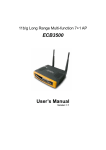
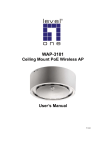
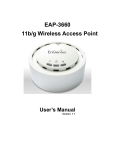

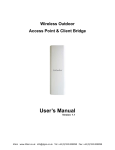
![Manual de usuario - [ [ [ ANSEL ] ] ]](http://vs1.manualzilla.com/store/data/006282114_1-2ccd0e24c76319024c067d083ee738a5-150x150.png)
